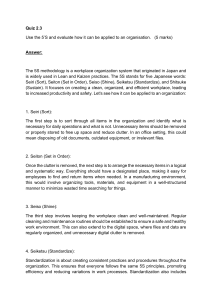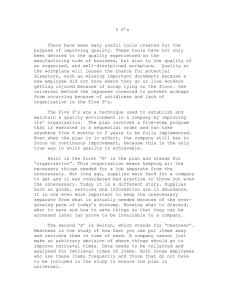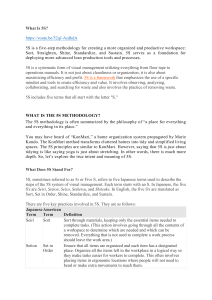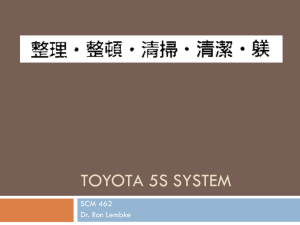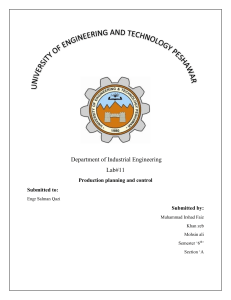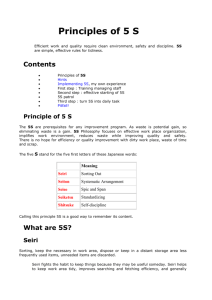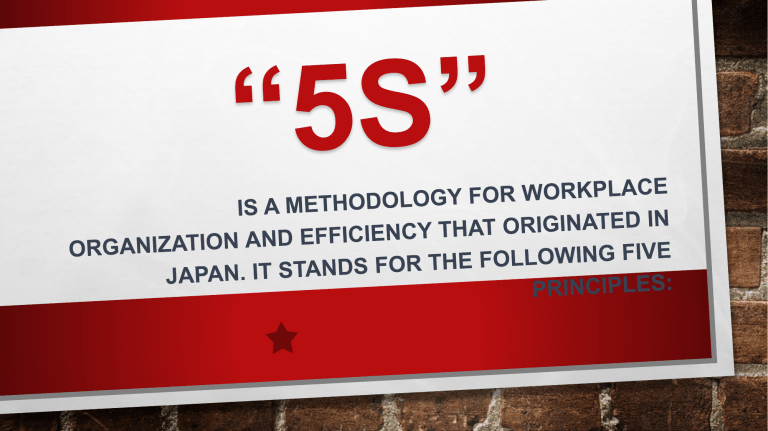
Sort (Seiri) • Seiri is the first step in the 5S methodology, which focuses on "Sort" or "Simplify" in English. It involves the process of sorting through items in a workspace and removing unnecessary items, clutter, and materials. The goal of Seiri is to create a more organized and efficient workspace by eliminating anything that is not essential for the current work process. Sort (Seiri) During the Seiri step, items are categorized into three main groups: Keep: Items that are essential for the current work process are kept. These are items that are frequently used and necessary for daily tasks. Discard: Items that are not needed, obsolete, broken, or no longer useful are discarded. This helps eliminate clutter and frees up space in the workspace. Reallocate: Items that are not needed for the current work process but might be needed in the future are reallocated or stored in a designated area. These items are not immediately accessible but can be retrieved if required. Sort (Seiri) The primary benefits of Seiri include: • Improved Efficiency: With only necessary items at hand, employees can work more efficiently without wasting time searching for tools or materials. • Reduced Clutter: Clearing out unnecessary items creates a cleaner and safer workspace, reducing the chances of accidents and improving overall organization. • Optimized Space: Removing unused items creates more space, making it easier to arrange tools and materials in an organized manner. • Cost Savings: Eliminating items that are not needed reduces waste and helps cut down on unnecessary expenses related to storage, maintenance, and replacement. • Enhanced Focus: A clutter-free environment allows employees to focus on their tasks without distractions from unnecessary items. BY APPLYING SEIRI, ORGANIZATIONS AIM TO CREATE A MORE PRODUCTIVE AND EFFICIENT WORK ENVIRONMENT, WHICH IS A FUNDAMENTAL GOAL OF THE 5S METHODOLOGY. Set in Order (Seiton) • Seiton is the second step in the 5S methodology, which focuses on "Set in Order" in English. This step involves arranging and organizing the items that were deemed necessary during the Seiri (Sort) step. The goal of Seiton is to establish a logical and efficient layout for tools, equipment, and materials, making them easily accessible and reducing waste in terms of time and effort. Set in Order (Seiton) Key principles of Seiton include: Designated Locations: Each item should have a specific, clearly marked location. This ensures that items are returned to their designated spots after use, making it easy to find them when needed. Visual Management: Visual cues such as labels, color coding, and shadow boards can be used to indicate where items should be placed. Visual management helps maintain organization and assists in quickly identifying missing items. Frequent Items within Reach: Items that are frequently used should be placed within easy reach, minimizing the need for excessive movement or searching. Set in Order (Seiton) Key principles of Seiton include: Logical Flow: Arrange items in a way that follows the natural workflow of the tasks being performed. This helps streamline processes and reduces unnecessary movement. Standardization: Establish consistent practices for how items are arranged. Standardization ensures that everyone in the workplace knows where to find and return tools and materials. Minimize Clutter: Avoid overloading work areas with too many items. Keep only the essentials in the immediate workspace to reduce visual and physical clutter. Set in Order (Seiton) The benefits of Seiton include: • Increased Efficiency: A well-organized workspace allows employees to quickly locate and access the tools and materials they need, reducing time wastage. • Reduced Errors: Clear organization reduces the chances of picking up the wrong tool or material, minimizing errors and improving quality. • Enhanced Productivity: With a logical layout, employees can move through tasks more smoothly, leading to improved productivity. • Safety Improvement: An organized workspace reduces the risk of accidents caused by clutter or improper storage. • Employee Satisfaction: A clean and organized workspace contributes to a positive work environment and can boost employee morale. SEITON, AS PART OF THE 5S METHODOLOGY, CONTRIBUTES TO CREATING A MORE EFFICIENT, ORGANIZED, AND STREAMLINED WORKPLACE THAT SUPPORTS OVERALL OPERATIONAL EXCELLENCE. Shine (Seiso) • Seiso is the third step in the 5S methodology, which focuses on "Shine" in English. This step involves thorough cleaning and inspection of the workspace, equipment, and tools. The goal of Seiso is to maintain a clean and orderly environment, identify and address any sources of dirt, dust, or potential problems, and promote a culture of cleanliness and preventive maintenance. Shine (Seiso) Key aspects of Seiso include: Regular Cleaning: Establish a routine for cleaning work areas, tools, and equipment. Regular cleaning prevents the buildup of dirt and debris, creating a safer and more pleasant work environment. Deep Cleaning: Conduct deep cleaning activities to remove accumulated dirt, grease, and grime. This can involve disassembling equipment for a thorough cleaning and reassembly. Inspection: During the cleaning process, carefully inspect tools, equipment, and work areas for signs of wear, damage, or malfunction. Identify any issues that require maintenance or repair. Shine (Seiso) Key aspects of Seiso include: Problem Identification: Use the cleaning and inspection process to identify potential sources of problems, such as leaks, loose parts, or areas prone to safety hazards. Standardized Cleaning Procedures: Develop and implement standardized cleaning procedures that outline tasks, responsibilities, and frequency of cleaning. This ensures consistency and accountability. Team Effort: Involve all team members in the cleaning process. Promote a sense of shared responsibility for maintaining a clean and safe workspace. Shine (Seiso) The benefits of Seiso include: • Safety Improvement: Regular cleaning reduces slip, trip, and fall hazards, and helps identify potential safety issues. • Preventive Maintenance: Identifying and addressing issues during cleaning can prevent equipment breakdowns and minimize downtime. • Improved Equipment Lifespan: Proper cleaning and maintenance can extend the lifespan of tools and equipment. • Health and Hygiene: A clean workspace contributes to a healthier and more hygienic environment for employees. • Enhanced Work Culture: Practicing Seiso fosters a culture of cleanliness, responsibility, and teamwork. SEISO, AS A CORE ELEMENT OF THE 5S METHODOLOGY, CONTRIBUTES TO CREATING A WORKPLACE THAT IS NOT ONLY EFFICIENT AND ORGANIZED BUT ALSO SAFE AND CONDUCIVE TO HIGH-QUALITY WORK. Standardize (Seiketsu) • Seiketsu is the fourth step in the 5S methodology, which focuses on "Standardize" in English. This step involves establishing standardized practices and procedures based on the improvements made during the previous 5S steps (Sort, Set in Order, and Shine). The goal of Seiketsu is to create consistency, ensure that the improvements are sustained over time, and provide a framework for continuous improvement. Standardize (Seiketsu) Key aspects of Seiketsu include: Documentation: Document the established procedures, guidelines, and standards for organizing, cleaning, and maintaining the workspace. This documentation serves as a reference for all team members. Training: Train employees on the standardized practices and procedures. Ensure that everyone understands the expectations and responsibilities related to maintaining the organized and clean workspace. Regular Audits: Conduct regular audits and inspections to assess compliance with the established standards. Identify any deviations or areas that require improvement. Standardize (Seiketsu) Key aspects of Seiketsu include: Continuous Improvement: Encourage a culture of continuous improvement by involving employees in suggesting and implementing enhancements to the standardized processes. Problem Solving: Develop a systematic approach to addressing any challenges or obstacles that arise. Encourage employees to collaborate on solving problems and making improvements. Visual Management: Use visual cues, such as signs, labels, and markings, to reinforce the standardized practices and procedures. Visual management helps remind employees of the expected standards. Standardize (Seiketsu) The benefits of Seiketsu include: • Consistency: Standardized practices ensure that everyone follows the same set of rules, leading to consistent and predictable outcomes. • Sustainability: The improvements made during the earlier 5S steps are more likely to be sustained over time through standardized practices. • Efficiency: Standardization reduces variations and streamlines processes, leading to increased efficiency and productivity. • Employee Empowerment: Involving employees in developing and refining standardized procedures empowers them and fosters a sense of ownership. • Quality Improvement: Standardized processes contribute to improved product or service quality by minimizing errors and inconsistencies. SEIKETSU IS AN ESSENTIAL STEP IN THE 5S METHODOLOGY AS IT PROVIDES THE STRUCTURE AND FRAMEWORK FOR MAINTAINING AND CONTINUOUSLY IMPROVING THE ORGANIZED AND EFFICIENT WORK ENVIRONMENT ESTABLISHED THROUGH THE PREVIOUS STEPS. Sustain (Shitsuke) • Shitsuke is the fifth and final step in the 5S methodology, which focuses on "Sustain" or "Self-Discipline" in English. This step is about maintaining the improvements achieved through the previous 5S steps (Sort, Set in Order, Shine, and Standardize) and embedding the 5S practices into the organizational culture. The goal of Shitsuke is to create a lasting change by instilling self-discipline, continuous improvement, and a sense of responsibility among all team members. Sustain (Shitsuke) Key aspects of Shitsuke include: Commitment: Encourage all employees to take ownership of the 5S practices and commit to maintaining the organized, clean, and efficient work environment. Training and Education: Provide ongoing training and education to ensure that new employees are introduced to the 5S principles, and existing employees are reminded of their importance. Regular Audits and Assessments: Continue conducting regular audits and assessments to monitor compliance with the 5S practices. Recognize and address any deviations promptly. Sustain (Shitsuke) Key aspects of Shitsuke include: Recognition and Rewards: Acknowledge and reward individuals or teams that consistently adhere to the 5S principles. Positive reinforcement encourages continued commitment. Problem Solving: Empower employees to identify and solve problems related to the 5S practices. Encourage a culture of continuous improvement and innovation. Feedback Loop: Establish a feedback mechanism for employees to provide suggestions and improvements for the 5S processes. Sustain (Shitsuke) The benefits of Shitsuke include: • Long-Term Sustainability: Shitsuke ensures that the 5S practices become an integral part of the organizational culture and are sustained over the long term. • Improved Morale: A clean, organized, and efficient work environment contributes to higher employee morale and job satisfaction. • Consistent Productivity: The self-discipline developed through Shitsuke helps maintain consistent levels of productivity and quality. • Waste Reduction: Continuously adhering to the 5S practices helps prevent the reaccumulation of clutter and waste. • Continuous Improvement: The culture of self-discipline and responsibility fosters an environment of continuous improvement and innovation. SHITSUKE IS A CRITICAL STEP IN THE 5S METHODOLOGY AS IT ENSURES THAT THE BENEFITS OF 5S ARE NOT TEMPORARY BUT BECOME AN INTEGRAL PART OF HOW WORK IS DONE, LEADING TO LASTING POSITIVE CHANGES WITHIN THE ORGANIZATION. MULTIPLE CHOICE: SELECT THE
